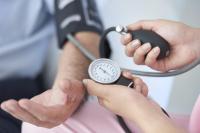Understanding the New Blood Pressure Treatment Guidelines
5 Questions About Hypertension with Andrew Moran, MD

Last November, the American College of Cardiology and American Heart Association issued the first new set of hypertension treatment guidelines since 2003. Overnight, some 30 million more Americans had high blood pressure.
For decades, high blood pressure in most patients was defined as 140/90 mmHg or higher (the first number measures systolic blood pressure, when the heart contracts; the second measures diastolic pressure, when the heart relaxes).
The new guidelines lower the threshold in all patients to 130/80, and the change has prompted debate among physicians in the medical literature and in the mass media.
To explain what the new guidelines mean for patients and clinicians, we talked with Andrew Moran, MD, an internist at Columbia University Irving Medical Center. Moran is the principal investigator of an NIH-funded project comparing the effectiveness and costs of U.S. national hypertension treatment guidelines. He was recently invited by JAMA Internal Medicine to comment on recent hypertension research.
The guidelines lower the threshold for a diagnosis of high blood pressure to 130/90. Why was this changed?
With the previous guidelines, hypertension was diagnosed in adults with blood pressure greater than 140/90, and treatment was aimed at reducing blood pressure in most patients to a systolic pressure below 140.
The current lower diagnostic threshold for hypertension diagnosis is justified by numerous large observational studies, which established that even people with a systolic pressure above 130 (or a diastolic pressure above 80) have an increased risk for heart disease or stroke.
The new guidelines differ from the past in recommending medication for adults with blood pressure between 130/80 and 140/90 who have any the following risk factors: diabetes, chronic kidney disease, cardiovascular disease, or a 10-year predicted cardiovascular disease risk of at least 10 percent. Medication is also recommended for adults age 65 years or older with a systolic pressure of 130 or greater. The treatment target goals are also new, with a goal of reaching below 130/80 for all adults taking antihypertensive medication. For those over 65, the goal is to achieve a systolic pressure below 130.
The new treatment guidelines were strongly influenced by the results from SPRINT (Systolic Blood Pressure Intervention Trial), which were published in 2015. The SPRINT study compared intensive treatment of hypertension (to a target systolic pressure of 120) to standard treatment (to a target of 140) in more than 9,300 patients with systolic pressure of 130 or higher and high cardiovascular disease risk. The trial found that intensive treatment reduced cardiovascular disease events and all-cause deaths compared with standard treatment.
Why do you think there’s confusion among the public and physicians about the new guidelines?
I think the hardest thing to grasp is that for low-risk, younger patients with systolic pressure between 130 and 140, medication is rarely indicated. They are given a diagnosis of hypertension, but the only recommendation is to improve diet and exercise more. The main purpose of diagnosis in that group is to notify people about their risk and motivate them to make behavior changes.
What people don’t realize when they hear about thresholds for high blood pressure is that there is a continuous relationship between blood pressure and risk for heart attack and stroke. People with naturally lower blood pressures have lower risk for these conditions. People with blood pressure of 130/90 have a higher risk than people with 120/80—even though both of those measurements were considered normal in the past. So even moderately high blood pressure (below past diagnostic thresholds) is unhealthy.

The big question for clinical practice is, does "lower is better" always apply when we lower blood pressure with drug treatment? It is not 100 percent clear. Medications can be life-saving, but too much medication may also lead to unwanted consequences, like dizziness, falls, high potassium, or kidney injury.
The strongest evidence supports intensive treatment to a lower blood pressure target in patients with a diagnosis of heart disease or stroke.
Some physicians are saying that these guidelines will lead doctors to be too aggressive with treatment. Do you think that’s true?
I don't think so. Even though hypertension diagnosis was expanded, antihypertensive treatment is not indicated for the low-risk patient with mildly elevated blood pressure.
We did see more frequent occurrences of particular serious adverse events—hypotension, fainting, electrolyte abnormalities, and acute kidney injury—in the intensive treatment arm of SPRINT. Even though SPRINT’s intensive treatment had benefits for older, frail participants, clinicians worry that the trial’s participants were healthier than the general population in other ways, meaning that we may underestimate the risk of side effects resulting from intensive blood pressure treatment.
Clinicians and patients must weigh the expected benefits and risks and decide together about whether to treat blood pressure and how intensively to treat it. For the patient with cardiovascular disease, or high risk of developing cardiovascular disease, the preponderance of evidence supports treatment with medication.
In your recent commentary in JAMA Internal Medicine, you and your co-authors wrote that it’s time to take a "precision approach" in deciding whom to treat for high blood pressure. What do you mean?
Our group estimates that up to 16.8 million U.S. adults meet the SPRINT eligibility criteria and could be considered for intensive blood pressure treatment, including 51 percent of whom are currently untreated. Intensive treatment requires more office visits, medications, and investment, and it is unclear if the U.S. health system has the capacity to deliver that much extra care.
A precision approach can help us to identify the optimal patients—those with the highest expected benefit and lowest expected risk—and prioritize them for intensive treatment. My group is starting an NIH-funded study, an ancillary study to SPRINT called “Optimize SPRINT,” to develop a method for identifying these patients.
As you mentioned above, we often hear that only half of people with hypertension know they have it, and many of those who know it don’t have it controlled. Has this gotten better over time? Are there any disturbing trends?
As we consider lower blood pressure thresholds for starting medication and investment in intensive blood pressure treatment in high-risk adults, it is important to take stock of how we are doing in terms of achieving the old “standard” goal of 140/90 mmHg.
It is a sobering fact that in the most recent U.S. survey (2015-2016), less than half of patients with hypertension had their blood pressure controlled to under 140/90. That is a reversal, since over 50 percent had achieved control from 2009-2014.
We should devote energy and resources to closing the existing shortfalls in basic hypertension care for all patients, along with extending treatment to the high-risk.
References
Dr. Moran is an associate professor of medicine at Columbia University Vagelos College of Physicians and Surgeons.
